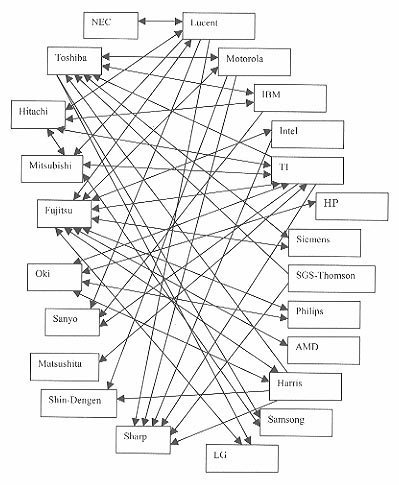Intellectual Property Rights Concerns: Obstacle to STKP
By Hajime Yamada (GLOCOM)
At commencement of the STKP project, negotiations were held with various organizations, including companies, which have a variety of S&T information. The most critical issue discussed at negotiations was the rule for handling Intellectual Property Rights (IPRs.)
Let us examine the importance of IPR, using an example.
In Japan, companies submit official annual reports to the Ministry of Finance (MoF) every fiscal year, and the reports are published by MoF. In an official annual report there is a description titled "Important Business Contracts," where important agreements of technology licensing are listed. Because companies can decide the importance of each contract, the list is not exhaustive. However, it is a good list for understanding the meaning of technology licensing in strategic business management.
The figure below shows relations among companies in the semiconductor business area based on information given in the reports for fiscal 1997. There are two types of lines in the figure. One type is lines with arrows on both sides, which means that two companies have a cross-licensing agreement. The other type is lines with one arrow, which means that technology is transferred unilaterally from one company to another based on a licensing agreement.

Some observations from the figure:
- Companies have various technology contracts. Because there could be other contracts not shown in the reports, one can say that all companies may have complicated technology relations with all others;
- Most of the contracts are cross licensing agreements. In these cases, in general no royalty is paid among contracting parties; and
- There exist several technology licensing contracts. In these cases licensees must pay royalty to licensors. Licensees found in the figure are companies that started semiconductor businesses relatively recently.
Lessons learned from the observations:
- In the high-tech business area such as semiconductors it is impossible for a company to do business utilizing only its own technology, because various companies proceed with R&D of the same area in parallel;
- If a company fails to hold IPRs during parallel R&D, the company needs to be a technology licensee. The necessity of royalty payment creates financial disadvantage to the company; and
- It is difficult for companies to manage competitions in R&D and cooperation in technology licensing relations simultaneously. Old corporate strategy by which IPRs were considered a tool to monopolize technology markets is simpler than today's situation.
For these reasons, companies have concerns about the treatment of IPRs in STKP. Because STKP is designed to exchange technology knowledge across institutional boundaries, there may be danger of leakage of IPR-related information among participants. It is, therefore, very necessary to implement some safeguards to resolve this concern. Safeguards provided are:
- To accept STDFs, activities of which are not disclosed to the public;
- To give the right to decide disclosure of information to Platform Masters (and participants);
- In general, to disclose abstract information only, with details kept secret; and
- To keep technology licensing negotiations outside STKP. Such negotiation is conducted by concerned parties only, or with an agent company. There is no obligation to report such negotiation to STKP.
The STKP is beginning to win broad acceptance from the S&T community because these safeguards are recognized as good measures. One influential company even proposes to utilize STKP as a forum to pursue de-facto standardization of high-tech products.
I will explain policy implications in the next issue.
| 




